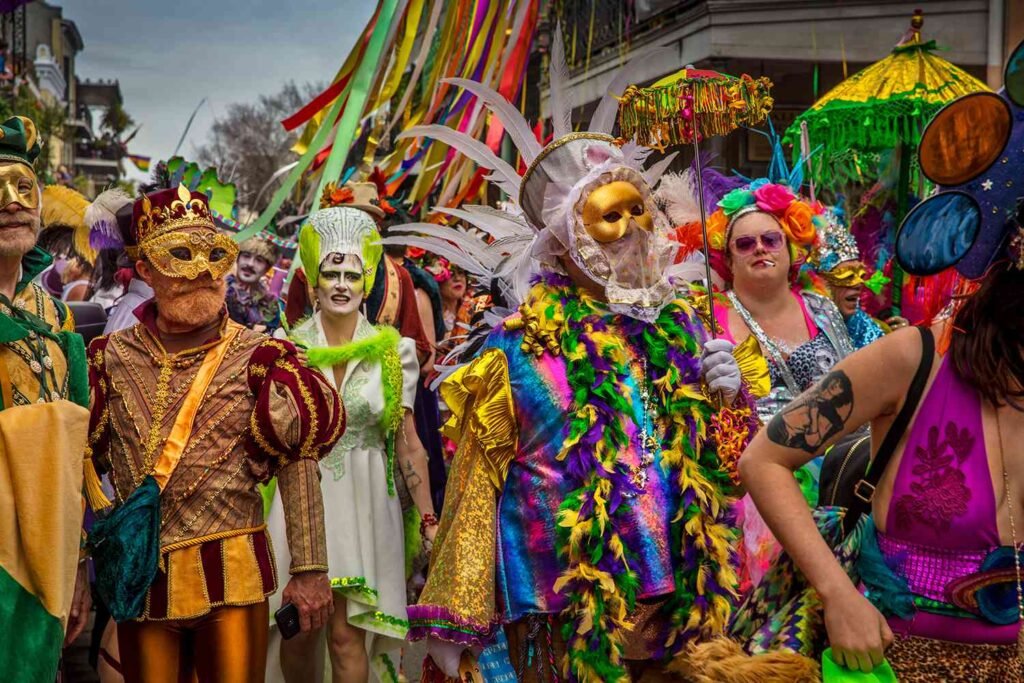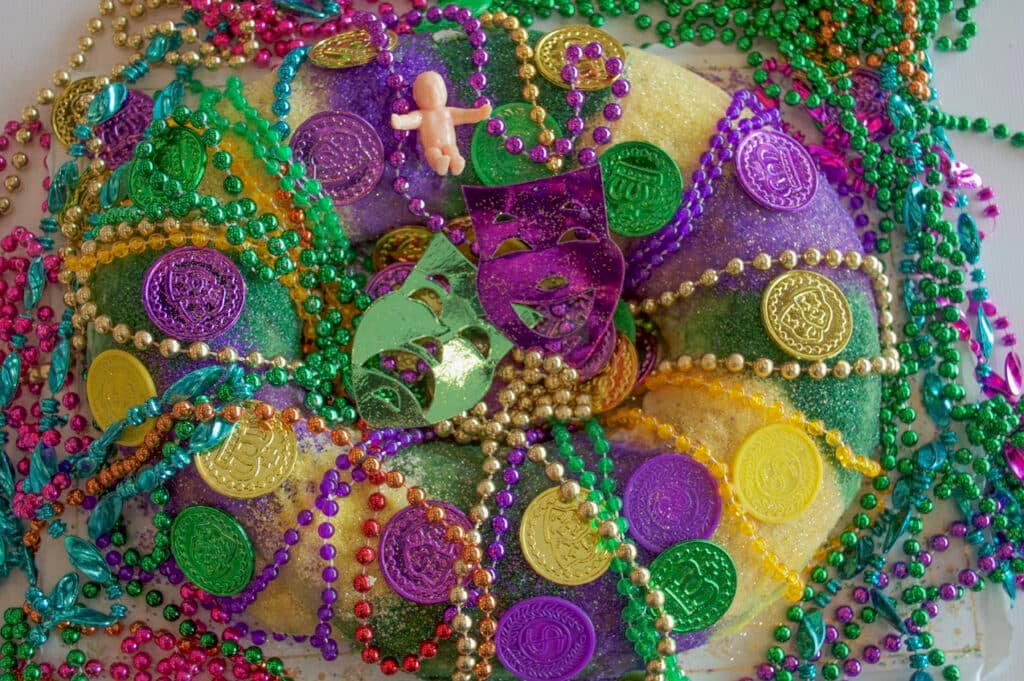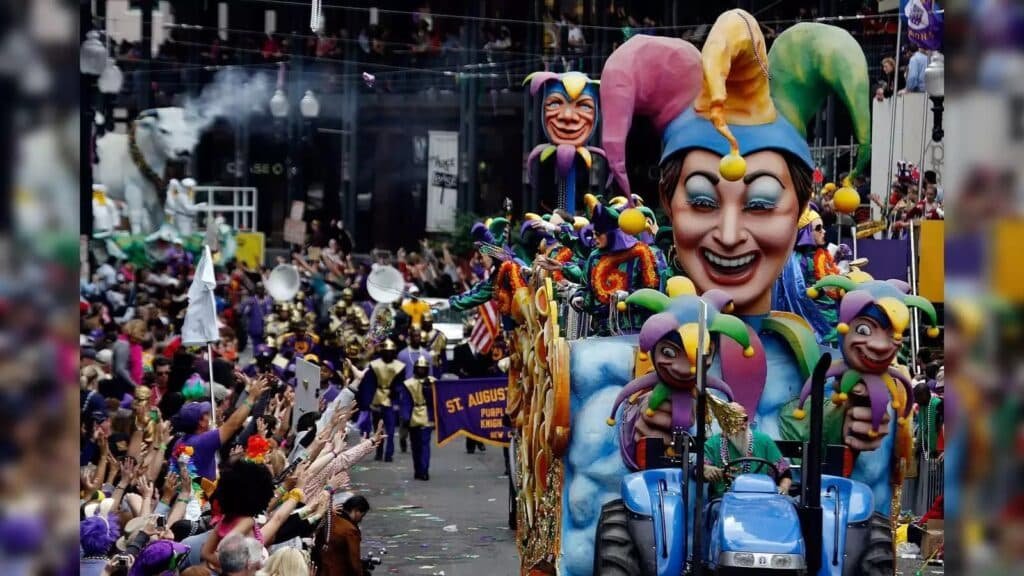Do you know what makes Mardi Gras in New Orleans so unique? The colors, music, and masked revelry create a captivating experience.
So, what’s the enchanting secret behind the magic of Mardi Gras in the heart of New Orleans?
Mardi Gras in New Orleans is a lively celebration filled with vibrant parades, masquerade balls, and a unique cultural tapestry.
In this article, we’ll explore the rich history and traditions that make Mardi Gras truly one-of-a-kind. From the origins of colorful masks to the significance of King Cake, join us on a journey through the heart of New Orleans’ festive spirit.
But there’s more to Mardi Gras than meets the eye. To uncover the real magic, we’ll go beyond the surface with the guidance of Dr. Angela Dupont, a respected cultural expert in New Orleans traditions.
Together, we’ll discover the hidden gems and lesser-known rituals that make Mardi Gras an extraordinary celebration that will also take place on Tue, February 13th, 2024.
Join us as we peel back the layers and immerse ourselves in the genuine magic of New Orleans’ most enchanting annual event.
The vibrant streets of New Orleans are about to come alive once again as Mardi Gras, the spectacular carnival extravaganza, is set to enchant both locals and visitors on February 13th, 2024.
Originating from medieval Europe and brought to America by the French-Canadian explorer Jean Baptiste Le Moyne Sieur de Bienville in 1699, the first Mardi Gras was celebrated in 1703 near New Orleans.
Fast forward to today, and the festival has evolved into a family-friendly carnival that blends rich traditions with contemporary festivity.
As the countdown to the festivities begins, let’s delve into the heart of Mardi Gras and discover why this annual celebration is more than just beads, masks, and parades.
Origins of Mardi Gras

The origins of Mardi Gras can be traced back to the European roots and its evolution over centuries.
The celebration began in medieval Europe, where communities engaged in festive pre-Lenten celebrations. These festivities, marked by elaborate costumes and masked balls, evolved as societies across the continent developed their unique traditions.
The influence of religious festivals, notably the Christian observance of Lent, played a significant role in shaping Mardi Gras. As European settlers migrated to the United States, they brought this lively tradition with them.
The first recorded Mardi Gras celebration in the United States occurred in 1703 in Mobile, Alabama, establishing a tradition that flourished in New Orleans.
Over the years, Mardi Gras adapted to the diverse cultural landscape of the United States, blending French, Spanish, African, and Creole influences to create the vibrant and eclectic celebration we know today.
The adaptation of Mardi Gras in New Orleans has made it an iconic and unparalleled cultural phenomenon, attracting visitors from around the world to partake in the grand festivities.
Key Traditions
One of the critical traditions that make Carnival Mardi Gras in New Orleans a truly grand celebration is the spectacular parade spectacles.
The heart of these parades lies in the elaborate floats and thematic displays organized by various krewes. Each krewe meticulously designs and decorates floats that reflect their unique themes, often inspired by mythology, history, or contemporary culture.
The iconic parade routes wind through the vibrant streets of the French Quarter, showcasing the city’s rich history and diverse neighborhoods.
The second major tradition is the vibrant costume culture, where locals and visitors immerse themselves in the spirit of the carnival. Traditional masks, reminiscent of Venetian masquerade balls, add an air of mystery and intrigue to the festivities.
Beyond masks, participants don elaborate costumes that follow specific themes, turning the streets into a kaleidoscope of colors and creativity.
The celebration is also synonymous with music and dance, featuring lively brass bands and second-line parades that infuse the atmosphere with infectious energy.
Additionally, the influence of Zydeco and Cajun rhythms adds a distinct Louisiana flavor to the festivities, making Mardi Gras a unique and unforgettable experience for all who revel in its traditions.
Culinary Delights

Culinary delights play a central role in the vibrant celebration of Carnival Mardi Gras in New Orleans, adding a rich flavor to the festivities.
The King Cake tradition highlights the culinary experience during this grand celebration. This iconic pastry, adorned with colorful sugar and often concealing a tiny plastic baby figurine, holds deep cultural significance.
Traditionally, whoever finds the baby in their slice is tasked with hosting the next Mardi Gras gathering. The festive table is adorned with Cajun and Creole cuisine, showcasing the region’s unique flavors.
From gumbo and jambalaya to étouffée and beignets, Mardi Gras is a feast of bold spices and rich textures. Additionally, the celebration is complemented by traditional cocktails, such as the classic Hurricane and Sazerac, which infuse the revelry with a spirited kick.
To further quench the thirst of partygoers, local brews and libations flow freely, offering a taste of the city’s diverse and dynamic beverage culture.
Carnival Mardi Gras is a gastronomic journey where the city’s culinary traditions take center stage, delighting locals and visitors alike.
Street Celebrations

In the heart of the vibrant Carnival Mardi Gras celebrations in 2024, the French Quarter stands as a pulsating epicenter of revelry.
Historic streets like Bourbon and Royal become animated canvases, adorned with colorful decorations and echoing with the lively beats of jazz music.
Iconic venues, such as the Preservation Hall, contribute to the festive atmosphere, hosting traditional jazz performances that encapsulate the spirit of New Orleans.
The streets themselves transform into stages, hosting a kaleidoscope of street performers and buskers, enchanting onlookers with their talents.
From mesmerizing magicians to soulful musicians, the French Quarter’s street celebrations create an immersive experience that encapsulates the city’s rich cultural tapestry.
Beyond the historic center, block parties and neighborhood celebrations add another layer of charm to the Carnival Mardi Gras experience.
These gatherings epitomize community engagement, fostering a sense of togetherness that extends beyond the exuberant chaos of the French Quarter.
Each neighborhood boasts its unique traditions, from costume contests to intricately themed parades, allowing residents and visitors alike to partake in the diverse tapestry of local customs.
These events showcase the true essence of New Orleans, where the Carnival becomes a communal celebration, bringing people from all walks of life together to revel in the shared joy of this grand spectacle.
The block parties and neighborhood celebrations are not just events; they are living expressions of the city’s deep-rooted cultural heritage.
Family-Friendly Aspects

In the midst of the lively and vibrant atmosphere of the Carnival Mardi Gras in 2024, families are sure to find an array of delightful and family-friendly activities.
Kid-Friendly Parades and Activities: Mardi Gras offers an assortment of parades specially crafted for the younger audience, featuring whimsical floats, costumed characters, and plenty of throws to capture the imaginations of the little ones.
From colorful beads to playful trinkets, these parades create an enchanting experience for children.
Additionally, various interactive activities and games are scattered throughout the celebration, ensuring the young revelers are engaged and entertained.
Educational Programs during Mardi Gras: New Orleans takes pride in infusing educational elements into the Mardi Gras festivities. Families can partake in informative programs that delve into the rich cultural history of the event, providing a unique opportunity for children to learn about traditions, customs, and the significance of this grand celebration.
Promoting Family Bonding in Festivities: Mardi Gras is a remarkable platform for fostering family bonds amidst the revelry. Whether it’s participating in a lively parade together, sharing the joy of discovering educational tidbits, or simply enjoying the colorful spectacle, the festivities create lasting memories that strengthen the ties among family members.
The inclusive nature of Mardi Gras ensures that every family member, regardless of age, can fully immerse themselves in the joyous spirit of this iconic celebration.
The Evolution of Mardi Gras Music
A. Traditional Influences:
At the heart of the vibrant Mardi Gras celebration in New Orleans is its rich musical heritage, deeply rooted in traditional influences.
The early days of Mardi Gras music were marked by the fusion of African rhythms, European melodies, and Caribbean beats, creating a distinctive sound that reflected the multicultural essence of the region.
Brass bands played a pivotal role in these festivities, blending military-style brass instrumentation with jazz, blues, and gospel elements.
The syncopated rhythms and improvisational spirit of these early performances laid the foundation for the unique Mardi Gras sound that continues to captivate audiences today.
B. Fusion Genres in Mardi Gras Music:
As Mardi Gras evolved over the years, so did its musical landscape. The celebration became a melting pot of genres, with artists and musicians experimenting and pushing boundaries.
The emergence of fusion genres like Zydeco, a blend of Cajun and Creole music, added a lively and infectious energy to the festivities.
Additionally, the incorporation of funk, soul, and R&B elements brought a new groove to Mardi Gras music, enhancing the overall dynamism of the celebration.
The interplay of diverse influences allowed Mardi Gras music to transcend traditional boundaries and become an eclectic and inclusive musical experience.
C. Modern Trends and Artists:
In recent years, Mardi Gras music has continued to evolve, embracing modern trends while honoring its historical roots. Contemporary artists, such as Trombone Shorty, Galactic, and Big Freedia, have revitalized the Mardi Gras sound by infusing it with hip-hop, electronic, and pop elements.
These musicians bring a fresh perspective to the celebration, attracting new audiences while maintaining the infectious spirit that defines Mardi Gras.
Incorporating technology, social media, and digital platforms has also expanded the reach of Mardi Gras music beyond the streets of New Orleans, allowing people worldwide to partake in the festivities and experience the dynamic evolution of this musical tradition.
Summary
In conclusion, the Carnival Mardi Gras of 2024 in New Orleans has proven to be a spectacular showcase of rich traditions, vibrant evolution, and global impact.
As we reflect on the festivities, the recap of key traditions reminds us of the cultural tapestry that defines this grand celebration.
The evolution of Mardi Gras over the years underscores its ability to adapt and resonate with people worldwide, transcending geographical boundaries.
Moreover, the global impact of Mardi Gras serves as a testament to its unifying power, fostering a sense of camaraderie and celebration across diverse communities.
In modern society, Mardi Gras holds significant importance as a historical event and a living tradition that continues to bring joy, color, and a spirit of togetherness.
As we bid farewell to the grand celebration, let the echoes of Mardi Gras inspire us to embrace traditions, appreciate cultural diversity, and celebrate the shared moments that make us human.
Frequently Asked Questions
How long is Mardi Gras 2024?
Mardi Gras 2024 falls on February 13th.
What happens on Mardi Gras in New Orleans?
On Mardi Gras in New Orleans, there are vibrant parades, lively street celebrations, elaborate costumes, and traditional music, marking the culmination of the Carnival season with festive revelry.
How much does it cost to go to Mardi Gras?
Attending Mardi Gras varies, but expenses include accommodation, food, transportation, and entertainment. On average, visitors may spend several hundred to a few thousand dollars, depending on preferences and choices.
How long does Mardi Gras last in New Orleans?
Mardi Gras in New Orleans typically lasts for about two weeks, with festivities beginning in early January and culminating on Fat Tuesday, which falls on the day before Ash Wednesday.